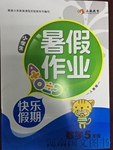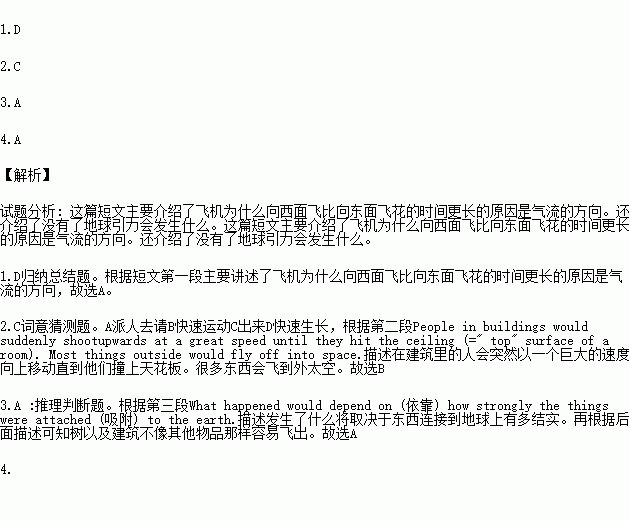题目内容
Have you ever wondered?
1. Why do airplanes take longer to fly west than east?
It can take five hours to go west-east from New York (NY) to London but seven hours to travel east-west from London to NY. The reason for the difference is an atmospheric phenomenon known as the jet(喷射) stream. The jet stream is a very high altitude wind which always blows from the west to the east across the Atlantic. The planes moving at a constant air speed thus go faster in the west-east direction when they are moving with the wind than in the opposite direction.
2. What would happen if the gravity on Earth was suddenly turned off?
Supposing we could magically turn off gravity. Would buildings and other structures float away? What happened would depend on how strongly the things were attached to the Earth. The Earth is moving at quite a speed, moving at over a thousand miles per hour. If you turn something round your head on a string, it goes around in a circle until you let go of the string. Things not attached to the Earth would fly off in a straight line. People in buildings would suddenly shoot upwards at a great speed until they hit the ceiling. Most things would fly off into space.
1. What information can we get from the first passage?
A. The jet stream always blows from the east to the west across the Atlantic.
B. Planes go slower when they are moving with the wind.
C. It takes more time to fly from NY to London than from London to NY.
D. It is the jet stream that affects how fast airplanes fly.
2. The word “shoot” underlined in the 2nd passage probably means“ ______”.
A. send for B. come out
C. move quickly D. grow quickly
3. It can be inferred that without gravity _________.
A. trees and buildings would not so easily fly off
B. buildings and other structures would float away
C. something around your head would not float away
D. everything outside buildings would fly off into space
4. Where can we most probably read this text?
A. In a student’s book B. In a short story
C. In a travel magazine D. In a research paper
 永乾教育寒假作业快乐假期延边人民出版社系列答案
永乾教育寒假作业快乐假期延边人民出版社系列答案假如你是北京阳光中学的李涛,今年暑假你打算到纽约自助游,你在沙发网上找到了一位愿意免费为你提供住宿的美国人Peter,请根据下表提供的信息,给Peter 写一封信,介绍你的情况以及你的需求。
注意:1. 词数不少于50;
2. 可适当增加细节,以使行文连贯;
3. 开头和结尾已给出,不计入总词数。
个人信息 | ●姓名:李涛 ●性别:男 ●年龄:17岁 ●能力:可以用英语进行交流 ●爱好:旅游和摄影 |
请求 | ●请求到机场接你 ●在Peter家免费住3天 |
Dear Peter,
_____________________________________________________________________
_____________________________________________________________________
_____________________________________________________________________
_____________________________________________________________________
_____________________________________________________________________
_____________________________________________________________________
Yours,
Li Tao


 y in our imagination or in science fiction (科幻小说).
y in our imagination or in science fiction (科幻小说). sible things can become possible and that’s why most of us like it. But science fiction is not entirely fiction since it is based on science theories (理论). Time travel, for
sible things can become possible and that’s why most of us like it. But science fiction is not entirely fiction since it is based on science theories (理论). Time travel, for